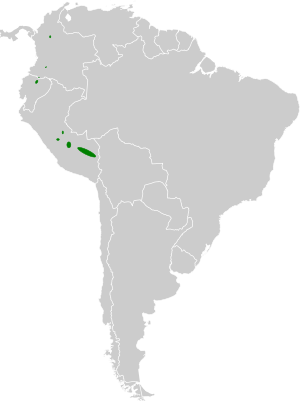Black tinamou facts for kids
Quick facts for kids Black tinamou |
|
|---|---|
 |
|
| Conservation status | |
| Scientific classification | |
| Genus: |
Tinamus
|
| Species: |
osgoodi
|
| Subspecies | |
|
T. o. osgoodi Conover, 1949 |
|
 |
|
The black tinamou (Tinamus osgoodi) is a type of bird that lives on the ground. You can find it in wet foothill and montane forests in the Andes mountains of South America.
Contents
Understanding the Black Tinamou's Family
All tinamous belong to the bird family called Tinamidae. They are also part of a larger group of birds known as Palaeognathae. This group includes birds like ostriches and emus, which are called ratites.
Tinamous are special because they are the only birds in their group that are not ratites. They can even fly, though not very well! Scientists believe that all birds in the Palaeognathae group evolved from ancient flying birds. Tinamous are the closest living relatives to these old birds.
A scientist named Henry Boardman Conover first described the black tinamou in 1949. He studied a bird specimen from Cusco in Peru.
Different Types of Black Tinamous
The black tinamou has two main types, called subspecies:
- T. o. hershkovitzi: This subspecies mostly lives in the Colombian Andes mountains. It is found at heights between 1,400 and 2,100 meters (about 4,600 to 6,900 feet). You can find it on the west side of the East Andes in the Huila Department. It also lives on the east side of the East Andes in the Caquetá Department. Some reports suggest it might also be in the northern Central Andes in Colombia and parts of Napo and Sucumbíos Provinces in Ecuador.
- T. o. osgoodi: This subspecies lives on the east side of the Peruvian Andes. It is found in areas like Cuzco, Puno, Madre de Dios, and Huánuco. It usually lives at heights of 900 to 1,400 meters (about 3,000 to 4,600 feet). However, sometimes it can be found as high as 2,100 meters (about 6,900 feet).
What Does a Black Tinamou Look Like?
The black tinamou is a sturdy bird that lives on the ground. It has a short tail and rounded wings. It is larger than many other tinamous, growing to about 40 to 46 centimeters (16 to 18 inches) long. Female tinamous are usually a bit bigger than males.
A male black tinamou's wingspan is typically 234 to 248 millimeters (about 9.2 to 9.8 inches). A female's wingspan is a bit longer, from 239 to 256 millimeters (about 9.4 to 10.1 inches). One male tinamou weighed about 1,285 grams (2.8 pounds).
Color and Features
Despite its name, the black tinamou is mostly a dark grey color, not truly black. Its upper body is a solid grey. The middle part of its body and its larger wing feathers sometimes have brown edges. Its lower chest and sides are a sooty brown, as is its belly. The area under its tail is reddish-brown. This area might have black spots, depending on the subspecies.
The top part of its beak is black, and the bottom part is light grey. Black tinamous have blue-grey legs and dark brown eyes.
Young Black Tinamous
Young black tinamous look similar to adults. However, they have whitish spots on their wing feathers. Baby black tinamou chicks have a light brown head with a wide, cinnamon-brown stripe. This stripe goes from the top of their head down to the back of their neck. Their throat and chin are whitish. Their neck, upper back, and upper chest are a dusty brown color. The lower back and rump of a chick are a dirty light brown. Their lower chest and belly can be anything from dusky brown to pale brown.
Sounds of the Black Tinamou
The black tinamou makes a shaky, descending whistle sound. This whistle lasts for about one second. It sounds similar to the call of a white-throated tinamou.
How Black Tinamous Behave
Scientists do not know much about the daily behavior of the black tinamou. However, they believe it acts much like its relatives. For example, nuts have been found in the stomach of one tinamou specimen.
How They Reproduce
Only one black tinamou nest has ever been found. It was on the ground and held two shiny blue eggs. In Peru, adult tinamous ready to breed have been seen between March and November. A chick was also found in February.
Protecting the Black Tinamou
The IUCN (International Union for Conservation of Nature) lists the black tinamou as a Vulnerable species. This means it is at risk of becoming endangered. Its habitat covers about 11,600 square kilometers (4,500 square miles). In 2004, experts thought fewer than 10,000 black tinamous were left. There are not many recent sightings of them in Colombia. While they were once common in some parts of Peru, they are now rare there.
The black tinamou lives in several protected areas. These include the Megantoni National Sanctuary, Manú National Park, and Sira Communal Reserve in Peru. They also live in Sumaco Napo-Galeras National Park in Ecuador and the Cueva de los Guácharos National Park in Colombia.
Threats to Their Survival
The black tinamou is in danger because its forest home is shrinking. This is due to:
- deforestation (trees being cut down)
- People building new homes and towns
- Farms expanding into their habitat
- New roads being built
- Oil exploration in Peru
- Being hunted for food
Even inside protected areas, hunting and habitat loss are still problems for the black tinamou.
See also
 In Spanish: Tinamú negro para niños
In Spanish: Tinamú negro para niños


